Weapons
The B-2 has two weapons bays. Each bay contains a rotary launcher. A launcher can only accommodate one type of weapon at a time, but each bay can contain a different type of weapon.
Nuclear
In the nuclear role the B-2 can carry up to sixteen of the following weapons:
AGM-129 Advanced Cruise Missile
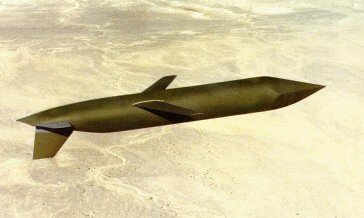 The Advanced Cruise Missile (left) was built as a stealthy replacement for the AGM-86, but the end of the Cold War caused production to be curtailed, and only 461 were built. The ACM carries a W80-1 nuclear warhead (5Kt or 170-200 Kt yield), is 6.84m long with a 3.34m wingspan, weighs 1680kg and has a range of 3000km. It has a number of design features to minimise radar cross-section, including a minimal number of straight edges, low-power sensors, forward-swept wings, fuselage RAM, a flush inlet and shielded exhaust.
The Advanced Cruise Missile (left) was built as a stealthy replacement for the AGM-86, but the end of the Cold War caused production to be curtailed, and only 461 were built. The ACM carries a W80-1 nuclear warhead (5Kt or 170-200 Kt yield), is 6.84m long with a 3.34m wingspan, weighs 1680kg and has a range of 3000km. It has a number of design features to minimise radar cross-section, including a minimal number of straight edges, low-power sensors, forward-swept wings, fuselage RAM, a flush inlet and shielded exhaust.
The B-2 carries the Mod 11 version of the B61 freefall nuclear weapon. This has a variable yield of between 10 and 340 Kt. The weapon's casing is specially strengthened, allowing it to be employed against hard buried targets.
The B83 is the USA's second most powerful nuclear weapon, with a variable yield of up to 1.2 Mt. It is optimised for accurate, low-level supersonic delivery against hard targets, but can also be used as an air-burst weapon (with or without parachute retardation).
Conventional
The B-2 is much more likely to be employed dropping conventional weapons. Although it only has two weapons bays, it can carry about the same number of weapons as the B-1.
The Mk82 is a 500lb gravity bomb. It was the first weapon cleared to be dropped by the B-2. Up to 80 can be carried.
GPS-Aided Munition (GBU-36,GBU-37)
The Global Positioning System Aided Munition (GAM) was developed by the Air Force and Northrop Grumman as an interim precision munition for the B-2. GAM is a tail kit that fits on the 2000lb Mk84 general purpose bomb [GBU-36/B], or the 4500lb BLU-113 penetrator [GBU-37/B]. GAM uses GPS guidance to more accurately guide to target locations. The GBU-37 was added to the B-2 arsenal in late 1997. 16 GBU-36s or eight GBU-37s can be carried.
Around 700 GBU-36/B were dropped by B-2s during Operation Allied Force. Target destruction rate was estimated at 87%.
A few GBU-37/Bs were expended against enemy targets during Operation Enduring Freedom. It is possible that the weapon was also used during Operation Allied Force.
 |
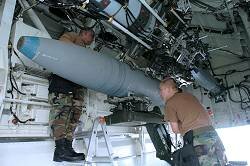 |
The B-2's main conventional weapon is the precision-guided 2000lb GBU-31 JDAM. JDAM is basically a tailkit that turns a 2000lb Mk 84 general purpose bomb or a BLU-109 penetrator bomb into a GPS-aided INS-guided precision weapon. The B-2 can carry sixteen GBU-31s.
About 90 GBU-31s were expended by the B-2 during Operation "Enduring Freedom".
The GBU-38 is a Mk82 500lb general purpose bomb with a GPS tailkit added. In March 2006 Northrop Grumman announced that it had completed an upgrade of the B-2's smart bomb rack assemblies (SBRA) to allow the aircraft to carry 80 GBU-38s.
The GBU-28C/B is an enhanced version of the 5000lb GBU-28 penetrator. It has GPS/INS rather than laser guidance. It is only carried by the B-2 and F-15E.
 The CBU-87 Combined Effects Munition contains 202 BLU-97/B combined effects bombs, which when released have a footprint of about 200 x 400m. The bomblets are effective against light armour, personnel and materiel. Each bomblet is approximately 20cm long and 6cm in diameter. The CBU-87 is 2.3m long and 0.4m in diameter, and weighs 431kg. The B-2 can carry 36 CBU-87s.
The CBU-87 Combined Effects Munition contains 202 BLU-97/B combined effects bombs, which when released have a footprint of about 200 x 400m. The bomblets are effective against light armour, personnel and materiel. Each bomblet is approximately 20cm long and 6cm in diameter. The CBU-87 is 2.3m long and 0.4m in diameter, and weighs 431kg. The B-2 can carry 36 CBU-87s.
 The CBU-89 Gator is an area-denial cluster weapon, containing 72 BLU-91/B anti-tank and 22 BLU-92/B anti-personnel mines. In this configuration it weighs just under 1000lb. It is 2.3m long and 0.4m in diameter. The size of the minefield depends on the height that the weapon is released from, but it is typically 200 x 650m. The B-2 can carry 36 CBU-89s.
The CBU-89 Gator is an area-denial cluster weapon, containing 72 BLU-91/B anti-tank and 22 BLU-92/B anti-personnel mines. In this configuration it weighs just under 1000lb. It is 2.3m long and 0.4m in diameter. The size of the minefield depends on the height that the weapon is released from, but it is typically 200 x 650m. The B-2 can carry 36 CBU-89s.
CBU-97
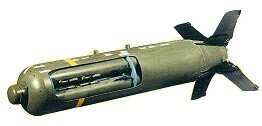 The CBU-97 Sensor-Fuzed Weapon contains ten BLU-108/B submunitions, each containing 4 armour-penetrating projectiles with infrared sensors to detect infrared targets. At a preset altitude a rocket motor fires to spin the submunition and initiate an ascent. The submunition then releases its four projectiles, which are lofted over the target area. The projectile's sensor detects a vehicle's infrared signature, and an explosively formed penetrator fires at the heat source.
The CBU-97 Sensor-Fuzed Weapon contains ten BLU-108/B submunitions, each containing 4 armour-penetrating projectiles with infrared sensors to detect infrared targets. At a preset altitude a rocket motor fires to spin the submunition and initiate an ascent. The submunition then releases its four projectiles, which are lofted over the target area. The projectile's sensor detects a vehicle's infrared signature, and an explosively formed penetrator fires at the heat source.
The CBU-97 is 2.3m long and 0.4m in diameter, and weighs 420kg. It can cover an area of about 150 x 400m. The B-2 can carry 36 CBU-97s.
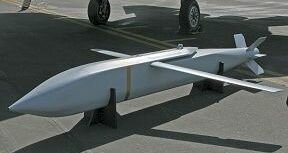 JSOW is intended to provide a low cost glide weapon with a standoff capability from 30km to 70km, depending on launch altitude. It is a launch and leave weapon that employs a tightly coupled GPS/INS navigation system for midcourse navigation and imaging infra-red and datalink for terminal homing.
JSOW is intended to provide a low cost glide weapon with a standoff capability from 30km to 70km, depending on launch altitude. It is a launch and leave weapon that employs a tightly coupled GPS/INS navigation system for midcourse navigation and imaging infra-red and datalink for terminal homing.
JSOW is just over 3.9m long and weighs between 450kg and 680kg. Extra flexibility has been built into the missile by its modular design, which allows several different submunitions, unitary warheads, or non-lethal payloads to be carried. JSOW-A (AGM-154A) dispenses 145 BLU-97 combined-effects bomblets which are used to attack soft targets such as SAM sites or airfields. The JSOW-B (AGM-154B) dispenses 6 BLU-108 anti-armour submunitions. The B-2 can carry 16 AGM-154s.
AGM-158 Joint Air to Surface Standoff Missile
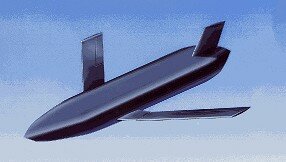 JASSM is a precision cruise missile designed for launch from outside area defences to kill a variety of fixed and relocatable targets. After launch, it will be able to fly autonomously over a low-level, indirect route to the target area where an autonomous terminal guidance system will guide the missile in for a direct hit.
JASSM is a precision cruise missile designed for launch from outside area defences to kill a variety of fixed and relocatable targets. After launch, it will be able to fly autonomously over a low-level, indirect route to the target area where an autonomous terminal guidance system will guide the missile in for a direct hit.
JASSM's midcourse guidance is provided by a GPS-aided inertial navigation system protected by a new anti-jam GPS null steering antenna system. In the terminal phase, JASSM is guided by an imaging IT seeker and a target recognition system that provides aimpoint detection, tracking and strike.
The B-2 can carry 16 AGM-158s.
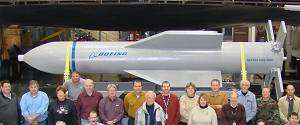 Boeing is developing a 30000lb (13.7 tonne) weapon for use by the B-2 against deeply buried hard targets. The weapon could be operational in 2008.
Boeing is developing a 30000lb (13.7 tonne) weapon for use by the B-2 against deeply buried hard targets. The weapon could be operational in 2008.
The MOP is approximately 20.5 feet long, with a 31.5-inch diameter and a total weight of slightly less than 30,000lb (13.6 tons). The weapon will carry over 5,300lb (2.4 tons) of explosive material. It is designed to penetrate 200 feet through 5,000 psi reinforced concrete, 125 feet through moderately hard rock and 25 feet through 10,000 psi reinforced concrete.
A B-2 would be able to carry one MOP in each weapons bay.
![]()
| <<< Structure and Systems | Top | Development >>> |
